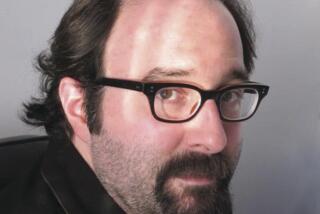It’ll be a bug’s life
- Share via
Tomorrow Now
Envisioning the Next Fifty Years
Bruce Sterling
Random House: 352 pp., $24.95
*
Any good futurist will tell you that the future can’t be predicted. Not many professions declare the impossibility of what they’re paid to do, but Delphic oracles, fortunetellers and Miss Cleo have set the bar pretty low. Besides, the most successful futurists avoid highly specific predictions in favor of “scenarios,” sweeping landscapes of a world that is strange and alien yet plausible. Scenarios are supposed to challenge convention and encourage readers to question their everyday assumptions. For futurists, then, being wrong isn’t a liability; it’s a little beside the point.
Bruce Sterling’s quest in “Tomorrow Now: Envisioning the Next Fifty Years” is to describe the “basic attitudes and deep convictions” that will order life 50 years from now. As one of the founders of cyberpunk, Sterling is disposed to look for “the oddity that is destined to become a great commonplace,” the anomaly that will overturn the dominant paradigm. He focuses in particular on biotechnology, education, industrial design, security, media, politics and mortality (seven sections that he models on the seven ages of man -- the infant, student, lover, soldier, judge, pantaloon and old man -- described in Shakespeare’s “As You Like It”). The result is a book “full of wise saws and modern instances,” as the Bard put it, that can also be frustrating.
Sterling’s best moments are those closest to science fiction, when he envisions a world that is “neobiological” -- in which technologies behave organically and biotechnology drives economic growth and the high-tech areas. But this is not a future of genetically engineered super-babies; instead, the real action will be at the bacterial level. Genetically modified foods are already controversial, and altering humans would be immensely more so. Bacteria, on the other hand, are easier to manipulate, can be manufactured by the tanker and don’t inspire warm, fuzzy feelings among activists. Harnessing bacteria will also change our sense of ourselves and our notions of health and cleanliness. “In a biotech world,” Sterling argues, “sterility is a confession of ignorance. It’s a tactic of desperation.”
Biological metaphors will also dominate design. We’ve already seen the emergence of “blobjects,” creations like the curvy cell phones, Palm Pilots and just about everything sold in the housewares section at Target. They’re intimate objects, designed to be kept close at hand or even worn on the body. Often their function is defined not by their shape but by the electronics they contain. Some products become blobjects just to be fashionable, but the most interesting ones are advance scouts of a brave new world in which devices communicate and work together, share information and energy and form a buzzing ecology of technologies.
But when “Tomorrow Now” turns from technical to social and political matters, it loses its assurance and focus. The main problem is that these chapters spend too little time in the future. The book’s method draws on fellow science fiction writer William Gibson’s declaration that the future is already here, just not evenly distributed. To see what the future will be like (to see “tomorrow now”), you just have to find the right Silicon Valley start-up, Seoul PC baang (Internet cafe) or networked protest movement. Sterling certainly has a good eye for the interesting story, but too often “Tomorrow Now” gets bogged down in the present and only hurriedly draws out lessons for the future. The book’s organization also emphasizes the trees and obscures the forest, making it difficult to see how the separate trends Sterling charts overlap or intersect. Finally, Sterling is too often overly modest in laying out his vision of the future or explaining what big forces will shape it. His strength as a stylist almost undercuts his insights.
Asking if “Tomorrow Now” is accurate is pointless: We won’t know for 50 years. Judged on its own terms, though, it is a mixed bag: At its best it is highly original, but other parts -- rather like the future -- are hazy and unformed.
More to Read
Sign up for our Book Club newsletter
Get the latest news, events and more from the Los Angeles Times Book Club, and help us get L.A. reading and talking.
You may occasionally receive promotional content from the Los Angeles Times.










